 |
|
John Grover worked in the editing department for six of the seven James
Bond films released between 1977 and 1989, graduating from assistant
editor on The Spy Who Loved Me, to assembly editor on Moonraker
and then ‘lead’ editor on For Your Eyes Only, The Living Daylights
and Licence To Kill as well as ‘supervising editor’ for
Octopussy.
007 MAGAZINE chief writer LUKE G. WILLIAMS spent an extended afternoon in
John’s entertaining and warm company at his Buckinghamshire home in 2011,
and we are now delighted to publish their full and frank conversation for
the first time… |
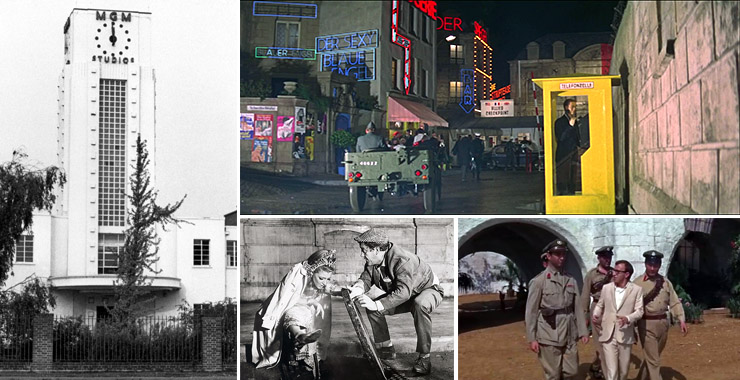 |
|
ABOVE: (left) The
MGM Studios Borehamwood clock tower demolished in 1973. The 1967
spoof James Bond film Casino Royale was filmed partly at
MGM Studios in 1966. Among those sequences filmed at the studio
were the Ken Hughes directed Mata Bond scenes in East/West Berlin
(top right & bottom centre [with Joanna Pettet and Bernard
Cribbins]). Filmed partly on the largest exterior
standing set at MGM, which had originally been constructed in 1964
as a Parisian suburb for the second Pink Panther film
A Shot
in the Dark, starring
Peter Sellers as the bumbling Inspector Clouseau. (bottom right) Woody Allen's firing squad scene was filmed on the
French village standing set originally constructed for Eye of
the Devil (1966), which had co-starred
Deborah Kerr and
David Niven. The same set would also later appear in the classic TV
series The Prisoner starring Patrick McGoohan, and can be
seen in the episodes ‘The Schizoid Man’, ‘A. B. and C.’ and
‘Living in Harmony’. |
|
|
|
Can you explain how
you got involved in the movie business?
I had to do National Service when I left school, and when I came out, I
did not want to follow my family into a profession. I was quite
well-educated but I wanted to do something that was more interesting. I’d
enjoyed taking black and white photographs, processing, and that sort of
thing, and I had an uncle whose name was Frank Clark, who was supervising
editor at MGM at Borehamwood. Well, I lived in Norwich, but I had a
grandmother who lived in Palmers Green, so I went and stayed there and got
a job at MGM. From there I was a numbering boy for two years. Numbering is
the lowest grade in the cutting room, it’s where you get the film in and
you put rubber numbers on, it doesn’t happen nowadays.
Then I became a second assistant, with Frank and then later with Ernie
Walter, then I became a first [assistant] and then assembly editor. I did
a lot of pictures with Ernie and travelled the world with him. Had a lot
of fun, went to Israel during the war, which was very interesting. I was
never really or very rarely out of work and got in with John Glen on a
picture that was shot in South America, Murphy’s War (1971). I got
on quite well with him and that’s how I started on the Bonds – which is
what you’re really interested in! |
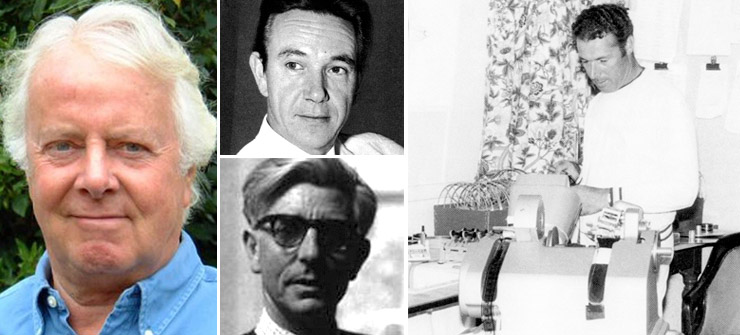 |
|
ABOVE: (left) John
Grover. (top centre) Doctor Zhivago editor Norman Savage
(1930-1973). (bottom centre) Sound Editor Winston Ryder
(1915-1999). (right) Editor John Glen at work on Murphy's War
(1971). |
|
|
|
What are your memories
of working on David Lean’s classic Doctor Zhivago as an assistant
editor?
That was when I had just got married, we’d bought a house, so we joined
the picture in Spain. I was on the sound with Win Ryder, Norman Savage was
the editor; Norman has died unfortunately and Win too so, unfortunately,
I’m the only one left. There are very few people left from Zhivago
now. That was a fantastic experience working with David Lean, of course it
was, but it was bloody hard work! He didn’t suffer fools gladly; we did
all the work in Spain and then we were shipped to America where we did the
post-production at MGM in Culver City. That was the start of my period
working either in England or Los Angeles. I got on very well with Mel
Chamberlain who was head of post over there. In fact they tried to get me
to stay over there, they poached people all the time, like they normally
do, the Americans! But my wife was very pregnant by then with my son and
she wanted him to be born over here, so we didn’t take that option up.
So I came back to England and finished Zhivago. We went to the
premiere. It was fantastic but it was hard work, every day, seven days a
week and we were in Los Angeles for probably seven months. The film was
much too long at the first opening, so we then had to re-cut, and shorten
the whole thing. After the premiere we had Christmas over there, we then
cut the picture again, or Norman did, and we had to re-dub it, of course,
so we stayed out there. It was very exciting, a terrific time.
What was next for you after Doctor Zhivago?
We came back here, and immediately I went on to… was it 2001 or
Grand Prix? I can’t remember which one. Let’s see – 1966 was Grand
Prix with John Frankenheimer, that was exciting, because of all the
motor racing with miles and miles of 65mm film, so that was a really big
logistical problem in the cutting rooms, with all the numbering and the
labs. I was once again taken back to Los Angeles to finish the picture
over there and dub it. I was on the picture with Fritz Steinkamp and Stu
Linder who got Oscars, I didn’t but they did, which was terrific for us,
and we got an Oscar for our sound editor [Franklin Milton] too. |
 |
|
What was Stanley
Kubrick like to work with on 2001: A Space Odyssey (1968)?
I’ve been asked that question many times! What did I think of Stanley
Kubrick? Well, the only time you were allowed to talk to him was when he
invited you into his inner sanctum. He would always be wearing his blue
suit. I was called in there one day because I was doing all the breathing
in the space suits. He would call me into the office and say: “this is
what I want you to do, I want you to wear the helmet and see what you come
up with”. So it would take two or three days in the theatre to shoot it,
then I’d go back, and synchronise it all. We shot on two lots of 35mm so I
could take the noises out because every time you moved you’d be hitting
the microphone, and you’d have to take out all the wheezing and sniffles
and all that sort of junk had to come out because it was just breathing he
wanted. Then I’d have to go with Win Ryder, who oversaw the sound, and sit
there with Kubrick in the theatre and run it. And he would never tell you
what he wanted – at the end of it he’d just say: “thank you John, OK,
let’s try it again”.
My theory is what he was doing was playing for time, for ever and ever. I
mean for six months I did this and each time I tried to make it different!
In the end it was a mixture of bits and pieces from each version.
Everybody says he was brilliant, of course. To me he was a very private
person. I’m not sure he always knew what he wanted, but if he had enough
things shown to him, he knew what he liked. He was clever. His death was
another loss we’ve had.
How did you first meet John Glen and work on the Bond films?
I’d done some assembly work for John and he liked me or liked what I’d
done. So he asked if I would like to come on The Spy Who Loved Me.
It was the opening sequence he was doing; he was going to be in Canada on
Baffin Island, and he wanted me in England to look at all the stuff and
report to him. After he’d shot it, he came back and he’d got that
absolutely wonderful shot of the parachute opening. I was his first
assistant. I didn’t go to Sardinia, but I went to some of the locations,
where he took the cutting rooms, locations where we normally had three or
four weeks. I did more locations on Moonraker, it was shot in
France, so we were in France all the time and I went to Venice. And on the
other Bond films I went to Corfu and Mexico – all over the world!
Absolutely terrific it was too! |
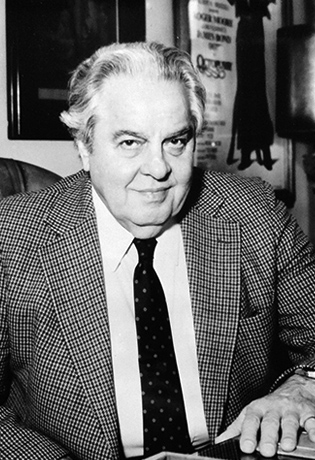 |
|
Albert R.
‘Cubby’ Broccoli (1909-1996) |
|
|
What was your opinion
of ‘Cubby’ Broccoli?
The first time I met him, he was a very impressive man, very big, very
large, very friendly, very jovial and – like most Americans – very good
with names! He always remembered my name which is flattering. He evidently
thought I was okay because I stayed with him and his family for a long
time. He was a lovely man and his wife was superb and very, very kind to
my wife. They got on well.
Cubby would usually come in every day to see the rushes. He was very much
a hands-on producer. If there was a problem, you could go to him. He was
unwell when we were in Mexico working on Licence To Kill – it was a
hard place to be. He had chest problems. So we used to send rushes up to
him In Los Angeles. If he didn’t like something, he’d tell us. He was very
direct, a good producer, a proper producer. There’s a lack of them now!
Cubby had a good sense of humour and would often deliberately sit me next
to the most controversial person at dinner in the green room at Pinewood.
There was this one American feminist I sat next to once. She challenged me
as the editor of Licence To Kill. She started talking to me about
what I thought about women in Bond films and why was it all ‘tits and
bums’ and I said because tits and bums are lovely! It was difficult
sitting with her! She was complaining about the sequence when Bond was
fondling for Pam’s gun, she was saying it was a sexist thing that you’re
showing her knickers! But that scene was fun! It was a good sequence! They
were good together there Tim and Carey! |
|
|
Your view of John Glen? And what was he like to work with?
He’s a superb second unit and action director, sometimes not terribly good
with people, artists were put on the picture and they played themselves…
Actually, maybe that’s a bit unfair to John, because Bond films were very
difficult because of time schedules. I mean they’re huge productions.
Massive. He delegated a lot, which was good, sometimes he upset people on
the set, which he’s allowed to do – he’s the boss!
John would come into the cutting room, not every night but whenever he had
time – purely because we needed to get stuff approved because we had such
a tight schedule. His favourite question was: “what else have you got?”
That’s what happens with most directors. Today working [on computers] it’s
soul destroying because you keep every single version you do and, in the
end… you don’t know what’s good! “Put it back the way it was” is a good
expression, because the first assembly that anybody makes is always the
most difficult. To try and tell a story as it was written in the script,
to try and get it grammatically correct and running comfortably is the
challenge, but after you’ve done that, then it’s easier to speed it up.
The key is to show everything in a dialogue scene and then start deleting
stuff. Don’t ever delete stuff before the director sees it though! That’s
not my job – that’s his job! |
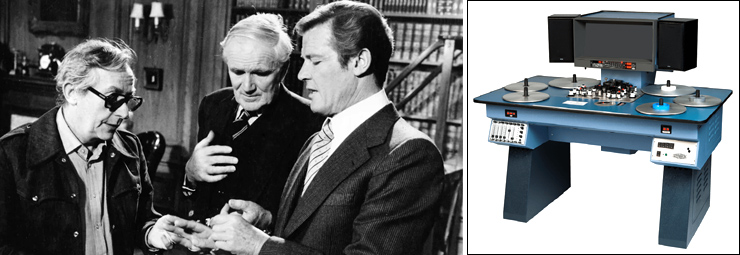 |
|
ABOVE: (left)
Moonraker (1979) - Director Lewis Gilbert, Desmond Llewelyn
(playing gadget master Q) and Roger Moore as James Bond rehearse a
scene on the M's office set that was shipped to Paris for filming.
(right) Founded in Germany in 1931, Steenbeck is a brand
name that has become synonymous with a type of flatbed film
editing suite which is usable with both 16mm and 35mm optical
sound and magnetic sound film. |
|
|
|
How about Lewis
Gilbert?
Lewis was terrific. He’d come into the cutting room with a glass of wine
and sit down. We had Steenbecks [a flatbed film editing suite] in those
days and we’d just run stuff. And he’d say: “well I don’t like that”, or
”do we have anything else for that?” But as long as the story was working,
he’d leave it to John [Glen] or myself. We had a lot of fun with him in
the cutting room. I saw him not very long ago. He got very involved – one
time when we were watching one sequence, he lent forward and said, “and
that’s where I wanted to go!”, put his glass of wine down and it shot all
over the film. It was very funny. We had to take it all off, dry it and
clean it. That was Lewis. Lovely. A lovely man.
How did it feel when you were offered the role of editor on For Your
Eyes Only?
It seemed like a natural progression but, of course, I was very flattered.
To sit in front of Cubby in the office with all the other heads of
department there and hear him say: “John, how do you feel… would you like
to do the job?” Of course I’d like to do the bloody job! It was a big
responsibility, but I had good assistants and John [Glen] was backing me
up all the time, so it was a very good arrangement – time consuming
though!
What are some of the biggest challenges of working on a Bond film?
What happens on a Bond film is they set the date that it’s going to be
released, and then they say, right, we’re going to release on this date so
if we’re going to shoot by this date, we’ve got to get a script by this
date. But they never had the script ready, or they hadn’t cast it fully in
time, so it always started late! So if shooting ran over, as an editor or
a post-production team we had no period we could over-run! We had to be
ready!
It was the same with Maurice Binder, he had to be ready for the opening of
the film! That became the difficult thing so then you would sometimes need
to take on more people. In that instance [on Octopussy] they called
me supervising editor because we had two or three editors on it, that
helped me out. It was a great learning stage for Peter [Davies] and for
Matthew Glen.
We always had problems with Maurice and the titles. We had one once with
pubic hair in the shot and that had to be taken out! Maurice was a naughty
boy! One Bond premiere I went to – Princess Diana was there – the titles
print arrived that day! I had to go to Rank, cut it in, make sure John was
OK with it and then take it back to London, that was quite frightening!
|
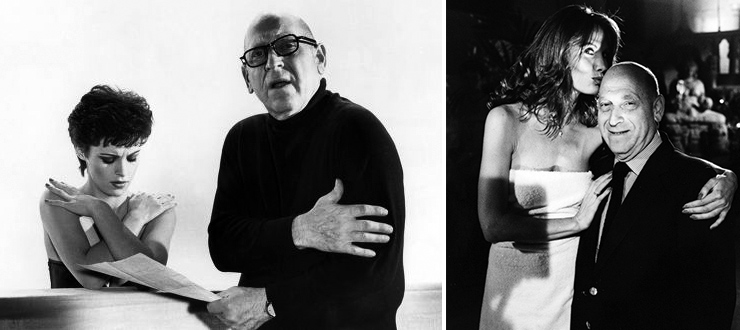 |
|
ABOVE: (left)
Maurice Binder filming the For Your Eyes Only (1981) main
title with singer Sheena Easton. (right) Binder with Maud Adams
who starred in Octopussy (1983). Maurice Binder's
provocative opening titles from the James Bond films often got him
into trouble with both censors and editors, due to their risqué
content and last-minute delivery! |
|
|
|
How did it compare
working with Roger Moore and Timothy Dalton?
Loved Roger! Terrific. Absolutely. Such a happy person to be with. If
there was any aggravation anywhere, he’d go out and buy 10 pounds of
sweets and throw them on the set. A terrific guy. I mean I don’t see him
very often but he’s another one who always remembers my name, always takes
the piss out of me! I loved him, and I still do. He was my favourite Bond.
I mean I didn’t work with Sean; I did a lot with Roger and with Tim. Tim
was a good actor but didn’t have a very good sense of humour. You don’t
feel as comfortable with him, he’s his own person. I think that would be
fair to say, but a very good actor. Roger was good at throwaway lines; Tim
wasn’t as good at that as Roger was or Sean was.
Can you explain the role of an editor and what the job involves on a
day-to-day basis?
It’s extremely different today to 20 years ago. A day in the life of a
film editor 20 years ago… For one thing the editor was on the payroll
from either a week before or certainly from the start of a main unit
shooting. He would be responsible with a team. I’d have an assembler, a
first assistant, a second assistant. The second assistant would do the
basic stuff such as synchronising the rushes, because everything was on
film then.
The film would come in from the labs and there’d be a lab report which I
would take to the set. The rushes would come in at about eight in the
morning and the sound would come off at nine or something like that. The
assistant would synchronise the rushes and if it was an action sequence
with a lot of gun shots we’d put a millstone round our necks because we
used to dub the rushes, temp dub them, because if you see a gun shot on
the rushes it just goes, pfft, there’s nothing! So we’d put a real gun
shot in, sometimes we’d put a flash in if the flash didn’t record. We’d do
that because when we ran rushes for Cubby, which was the most important
rushes for us of the day, the presentation, for me, was all important.
Cubby would come into rushes probably at half past 11. There’d always be
about half an hour of rushes, so he’d sit there and hopefully we’d dubbed
it and put some gun shots in.
We didn’t always run the second unit for him, because some of that,
especially with Derek Meddings’ stuff, was all high-speed stuff which
meant there was miles of run-up. We’d try to do that earlier in the
cutting room by taking all that run-up off, but that was very time
consuming and we didn’t often have the time for that. So we’d possibly
send him a selection of stuff to see at another time. |
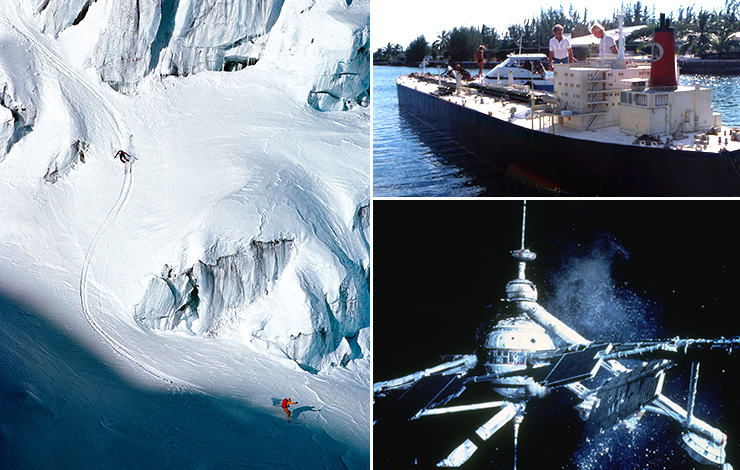 |
|
ABOVE: (left) The
spectacular pre-credit sequence for The Spy Who Loved Me
(1977) was filmed by editor and second-unit director John Glen on
Baffin Island in Canada, and in Switzerland by ski-chase
co-ordinator Willy Bogner. (top left) Derek Meddings [standing
centre left) on the miniature of the Liparus Supertanker, which
was filmed at high speed when moving in water so that the waves
appeared more realistic when projected at normal speed – this was
a technique Meddings pioneered on the groundbreaking TV puppet
series Thunderbirds (1965-66), which also worked well with
explosions and fire effects. (bottom right) Derek Meddings was
Oscar-nominated for his special effects work on Moonraker
(1979), which again utilised high-speed filming for the model
work, including the destruction of the Drax space station, which
was achieved by firing a shotgun at the large-scale miniature
filmed inside the vast ‘007 Stage’ at Pinewood Studios. |
|
|
|
The next running would be
the crew running in the evening when they’d finished shooting. The artists
didn’t normally come to that, I mean John didn’t like them there because
they would change their performances. But we would try to get make-up and
hairdressing there so that the main unit were looking like the doubles and
the doubles were looking like the main unit, so at least we didn’t have
wardrobe malfunctions and wardrobe that looked wrong. That could go wrong
and did go wrong, on one film we had someone who was meant to have a red
hat on and when it came out of the process it was a blue one!
The rest of the day you’d be assembling stuff. And everything had to be
numbered. Once they’d been synchronised, once everything was in synch, it
would be put on to a machine which would put rubber numbers on it. The
second assistant would then have a logbook and mark down what the numbers
were, and he would also key number it, which is what’s on the film stock
itself, so you knew what was in the laboratories later.
It’s so different today. Completely different. Then the film would be
broken down into small sections of film. Each would be a slate, you know
221 take 1, 2 and 3, you know whatever had got printed. Then I as the
editor I would have marked up my script . I’ve seen the rushes and I’d
marked my script. Sometimes if I was sitting with the director, I’d get a
nudge from John which means that’s the take he likes, or he liked that
bit. So I’d scribble something down and try to slot it in later. That’s
how we communicated.
Then I would put it together. I’d run it on a Moviola, which was a machine
that had a picture screen on the right and a sound head on there. So you’d
have the film coming off my hand. I’d be running it through, feeding it
through. I’d have bits that I liked which I would stop, look at, go
backwards and forwards… It’s difficult to explain! I could show you how to
do it – I could still do it today without any trouble! I’d mark it with
wax pencil where I wanted to start and stop. I’d take it out of there and
go onto a pic synch or a synchroniser and put it in there, so you keep it
in synch. You’ve got the numbers that are on the film and the soundtrack
which holds it in synch, that shows you it’s in synch.
Then you’d just wind it in and join it up with a tape joiner. When I first
started it was with a joiner where you had to do it with acetate and
scrape it and you lost two sprockets, but you didn’t 20 years ago, you
just joined it with a piece of tape. |
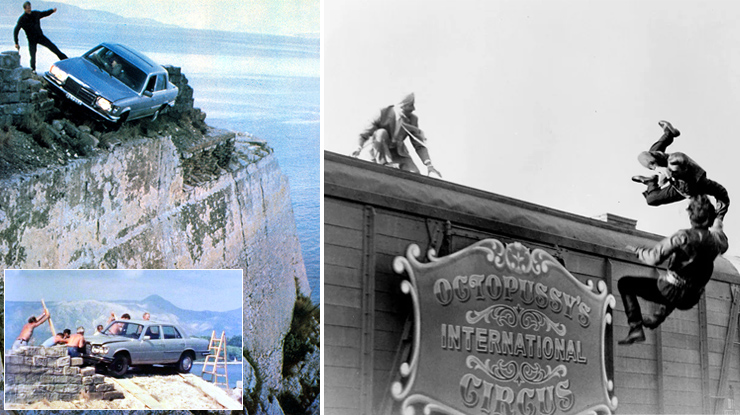 |
|
ABOVE: (left) For
Your Eyes Only (1981) One of Roger Moore's standout scenes as
James Bond is his ruthless killing of Locque (Michael Gothard) as
he kicks his car off a cliff in Corfu. The shot was achieved via a
combination of practical action, [inset] brute force, and clever
editing by John Grover and his team. (right) Similar techniques
were used in Octopussy (1983) for the culmination of the
fight on top of a speeding train. Pictured are Stuntmen Reg
Harding (doubling for Kabir Bedi as Gobinda), Paul Weston as James
Bond, and Wayne Michaels doubling Anthony Meyer (Grischka), on
location at the Nene Valley Railway in Cambridgeshire standing in
for West Germany. |
|
|
|
The film would gradually
be built up that way. So you’d have sequences – you’d label a sequence,
say sequence 22, and that would be in a can – well there’d be a can of
picture and a can of sound. So when John came in in the evening or
somebody else wanted to see it or the sound boys wanted to get hold of it,
they would take the sequence out and run it on a Steenbeck because you
didn’t get so much wear on a film that way. And you could go backwards and
forwards and see it in reasonable conditions, not like in a theatre but in
reasonable conditions. And you could stop and start it, and you could wax
it and say that’s incorrect or it’s uncomfortable because it’s jerky or
whatever. Editing is all about trimming and tightening. It’s a hands-on
thing.
If you were waiting for special effects shots, or whatever else, you’d
assemble and put it together and put a piece of blank film with ‘scene
missing’ where the special effects shots were going to go. In the end I
would have them shoot on a rostrum camera either a picture from the
storyboard, so you could then cut the sequence with a little bit of film
of the storyboard so that you could still show it and you could start
timing it.
The Bond films, when I was on them, they all had to be two hours and six
minutes! Ten doubles! You couldn’t go over that! Nowadays they’re shorter
– the last one was too short! To me you haven’t got enough story then.
Peter Hunt laid it all down originally. The philosophy is action, action,
action. It’s all go! Fast cutting. Enough cover so even if you have a slow
dialogue scene it doesn’t seem slow! Americans have an extremely low
attention span! No attention span at all! It must be bang bang! It’s like
MTV – moving wallpaper! But if you’re trying to tell a story you must
balance it… action sequences you can go faster and faster.
I’m not sure if it’s the case now, but on the Bonds the editor was always
taken out on location a week before shooting to set up. On The Living
Daylights I went out even earlier because we had to do playbacks. I
went to Vienna to do music playbacks and set that up. You’d normally start
about a week before although sometimes the film might have shot miles of
stuff before, specialist footage. On Moonraker we’d had
all this stuff shot in Brazil, so there was already a mass of film. And
you’d get the library material if you needed that, back projection shots
and so on. Those are so much better now with green screen and digital
photography. I mean some of the back-projection stuff we had on the Bonds
was awful! I shouldn’t say that, but they were! |
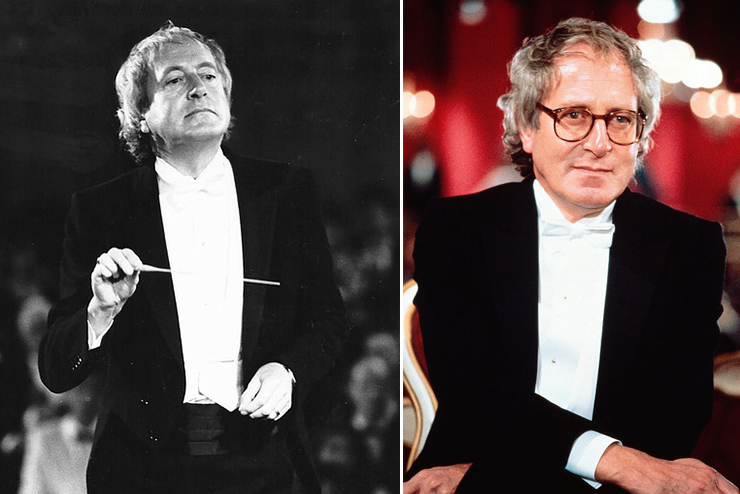 |
|
ABOVE: In addition
to composing the score for The Living Daylights (1987),
John Barry (1933-2011) also appears in the film as the conductor
of the Vienna Orchestra during the World Tour of Kara Milovy (Maryam
d'Abo). John Barry arranged Monty Norman's ‘The James Bond Theme’
for Dr. No (1962) and then went on to compose the music for
eleven James Bond films from 1963 to 1987. |
|
|
|
Did you often have to
delete whole sequences from a final cut of a Bond film?
We rarely lost complete sequences, what we’d often do is make them
shorter. The great thing about John Glen is that, having been an editor,
nothing was ever very long! You never have very many long cuts in a Bond
or long sequences because you can’t cut them. You do enough cover so the
film goes bang, bang, bang – and if a scene’s not working you can cut your
way out of it. Which sometimes can be annoying but sometimes can be a
great blessing, ok cut it there – bang it’s gone!
And your memories of the great John Barry?
I’d been with John Barry on other pictures, so I knew him. We were in
Vienna together for The Living Daylights. I got rather drunk with
John one day, that was Cubby’s fault because they were shooting a big
scene where he was supposed to conduct. It was being lit, it was a big
scene to light, the opera hall or whatever it was. We’d had lunch and
Cubby said to me: “you go and have lunch with John, and chat and look
after him for a while”. His wife had gone shopping I think, with Barbara
[Broccoli]. So they weren’t there. She used to look after him because he
liked his drink! He was a lovely man, very talented. Then John was called
on [set] and he couldn’t stand still! The story is, I don’t know if it’s
true because I wasn’t there, but somebody said that they nailed his shoes
to the floor so that he didn’t move. That’s possible! I don’t know if it’s
true but it’s a lovely story! He was terrific and he could conduct it
whether he was drunk or not!
Normally on a Bond film you’d have a music editor. I would always use
music from other Bond films, and we’d track the picture to it and cut the
picture to it because it creates a good rhythm. With John Barry you’d
leave the music in because most of it was his anyway and he’d use it and
adapt it. His music was very much part of the picture and made it work.
The music drove it.
How closely did you work with Michael G. Wilson & Barbara Broccoli?
The first Bond I was on; Barbara was just a pretty little girl who came on
the set with mum and dad. Michael was always around, and he was basically
a writer and a lawyer. As the pictures went on, they became more and more
involved. Michael would like his little acting bit where he’d get into
each film. Cubby was in one of them too in Venice. Barbara and Michael
aren’t my close friends but if I see them, we talk with no problem at all.
I respect them very much and love the family. |
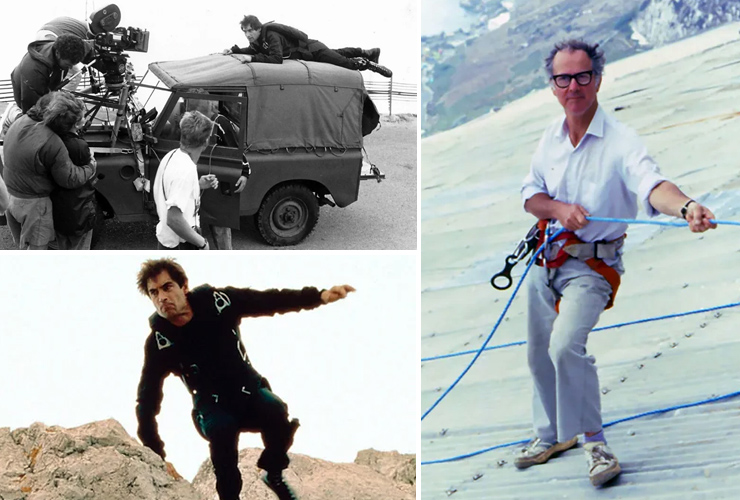 |
|
ABOVE: (left) The
Living Daylights (1987) New James Bond Timothy Dalton throws
himself into the action for the pre-credit sequence. (right)
Second unit director Arthur Wooster also gets in on the action in
order to capture the scenes filmed on the Rock of Gibraltar. |
|
|
|
Any other memories of
The Living Daylights?
We had a delay of course. We were going to have Pierce Brosnan as Bond,
and he would have been terrific. We’d done the artist test for him. I
liked him and thought he’d be a terrific Bond. Roger was too old, which
was sad. Tim got the job but unfortunately only did two. Early on we sent
Pete Davies out to Gibraltar – so he was working with the unit. When we
saw the footage back in England the insurers immediately tried to stop it
because Tim was doing the action, which you don’t allow really! He was
very hands-on. It was the start of the picture and he was trying to put
himself out there as a new Bond.
Timothy Dalton’s second Bond film Licence To Kill, was very
controversial in terms of its violence. I imagine that presented you with many
problems. What are your memories of the film and the challenges of editing
it?
They said they’d got to be more violent because all the other films that
were making money were violent. And not quite so much comedy. Tim didn’t
have that sense of humour, if things went wrong, he didn’t burst into
laughter. He was a very serious actor. I thought (that there’d be
censorship problems) I thought my goodness – it’s so graphic! I mean the
body going through the grinder and that sort of thing. Violence on screen
is incredibly easy to shoot, and to show violence off screen it’s got to
be done with sound, for which you need a good sound team, which we had.
We had troubles with the censor, which was a problem because it’s family
entertainment a Bond, and the kids are half the box-office. The censor
made us take a lot out and soften it. Cubby was really upset about that
because of other violent films that were being shown. I mean how did
Spielberg get away with some of his stuff? He got away with murder in the
Indiana Jones films.
When the baddie Robert Davi gets his comeuppance, I mean he deserved it!
He’d killed all these other people, completely ruthlessly! But anyhow, I
went to the censor, and physically re-cut it in front of him, you know
frame by frame. I said: ‘you’ve got to show the guy catching fire
otherwise it doesn’t mean anything!’
In the end it was a compromise and Cubby backed down, I think. We didn’t
have any bad language, but it was violent. With the mechanical shark,
blood and meat, it was rather gory. It was never real sharks, just pretend
ones. It was the blood they were worried about, too much red upsets
people! And of course the noise, the sound was equally responsible for the
violence. That was Vernon Messenger – blame him for that! The
grinder scene – that was the most violent. And that was violent in the
script, it had all been set up with all the blocks of drugs going through.
That was violent. And it was extremely violent when it was shot because of
all the gore and gunge they shot through, so we did cut most of that out.
But we had to show the threat, what would happen to Bond if he went into
it! They hadn’t had this extreme violence in a Bond film before. I didn’t
think it would disturb children, it might frighten them, but during
Doctor Who for goodness sake, children used to hide behind the settee.
So yes, we set out to make a more violent Bond, which we did. I suppose it
disappointed some of the older Bond people because they wanted us to
continue with the tongue-in-cheek humour, which we didn’t have. The Bond
story was becoming more up to date, not necessarily better but more up to
date. We did a lot of things the censor wanted. There was no terribly
violent sex stuff in it – there was a little bit of titillation but not
very much, there were just beautiful girls for goodness sake! They were
lovely. Carey Lowell was the most beautiful girl you can imagine! |
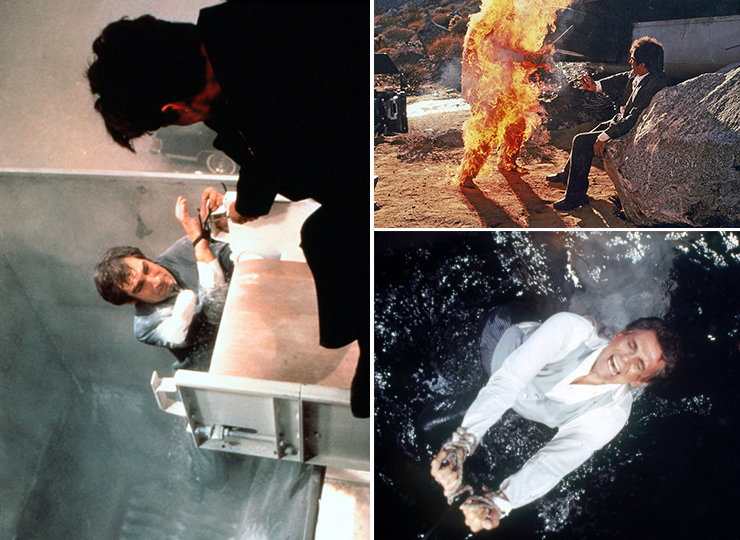 |
|
What was it like being
in Mexico? Any challenges?
Staying well! The food was okay, but you were always a bit sick, with an
upset tummy or something like that. It was extremely hot; we weren’t
allowed to drive. We had to have a chauffeur car or something because of
the danger. We were in a lovely hotel, but Churubusco Studios were
terribly run down. I think they probably ripped Cubby off… I remember a
lady coming out to paint an enormous backdrop, a huge backdrop, black with
stars, little bits of countryside, this that and the other. It was lovely.
Then Tim was in the boat with Carey Lowell in the romantic scene – it was
done on a big set. I remember how good that painted backdrop was.
What are your memories of the Kenworth truck sequence?
[Second unit director] Arthur Wooster had this enormous storyboard and
huge budget and just presented stuff wonderfully. He was very clever, and
it was very dangerous. How they got the authority to make explosions of
that size I’ll never know! Today you’d have major environmental problems
doing that. You’d do it miniaturised or with CGI, but they were all for
real!
Arthur used to come into the cutting room about once a week. He was at
Cancun, shooting up there and we were in Mexico City. He’d come in and I’d
work for a day with him there so he could see some of the stuff that he’d
done, and some of the stuff that we’d put together. I nicknamed him ‘Which
way Wooster’, because he’d always come in and say: “well, I’m going to
shoot this scene. Which way do you want to shoot it?” And I’d say:
“Arthur, I don’t know, we haven’t got the main unit yet. So I don’t know
if it’s left to right or right to left!” It depended on his storyboards,
but half the time because he had the money, the picture had the money,
they’d do it both ways so we could cut it left to right or right to left.
That’s why the sequence was so good, we had a mass of material. It still
looks good today; I don’t know whether it would be done for real today! |
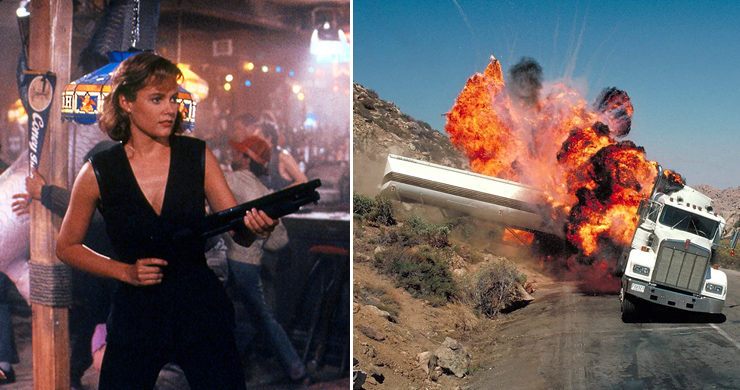 |
|
What work on
Licence To Kill are you most proud of?
Trying to make the Barrelhead bar-room sequence work… because it was the
first scene to be shot and, to be fair to the director, getting the crew
and all the artists to work together [at the beginning] is difficult. We
made it work in the end but I’m sure John Glen would agree it wasn’t the
best sequence. We had dancers, we had playback, villains, new characters.
It was a difficult scene to light… There were just too many things in
there. It just wasn’t a very good sequence. So to get that to work, I was
proud of that because that’s what an editor’s job is! You’ve got to tell
the story with the material you have. It’s no use saying, if I had a close
shot, I could have done that!
Sometimes on a Bond, if it really didn’t work, if you’re up to date, you
could go and see John and say, it’s really difficult, can you re-shoot
that? And he’d call Arthur in and he’d go and get a close-up and you could
get out of it. That was a privilege that we did have on the Bonds because
we had enough money. That’s also a good thing about having an editor on
location. It’s no use having him back in England and you’re on the other
side of the world!
And of all your Bonds, what was your best work do you think?
Working with Arthur Wooster’s material for the sequence with the train for
Octopussy. The chase. There was so much film to try and sort
through. John and Arthur loved it if you could get everything in that
they’d shot – even if it was just a three-foot cut! So to try to integrate
all this film and have the viewer still follow what’s happening, that’s
one that I was probably most pleased with. It was good – a lot of cuts!
What do you make of the most recent Bond films?
I enjoyed Casino Royale, but I didn’t like Quantum of Solace.
It was completely and utterly over-cut. It destroyed it. I’m sure there
was wonderful material and terrific action stuff, huge amounts of money,
which were destroyed in the cutting room. Although that’s perhaps being
unfair to the editors – the director just wanted to go faster and faster.
But it was not a computer game, it was a film! Watching it, you were
completely lost, if you hadn’t seen the film before you wouldn’t have
known what the hell was happening! No establishing shots, no tension! |



